Track
When I first explored AWS Lightsail, I was impressed by how simple and cost-effective it is for hosting applications, websites, and databases.
It is a great option for anyone new to cloud computing because it allows users to establish virtual private servers (VPS) easily, manage networking, and integrate AWS Lightsail with other AWS services.
Whether you are looking to deploy a personal website, an e-commerce store, or a lightweight database, Lightsail provides the tools necessary to get started.
By the end of this tutorial, you will have a working Lightsail instance, understand best practices for security and performance, and know how to scale your project as needed.
If you are new to AWS and want a broader understanding before diving into Lightsail, I recommend starting with an Introduction to AWS course to build foundational knowledge.
What is AWS Lightsail?
AWS Lightsail is a cloud service from Amazon that offers networking, databases, storage, and VPS hosting at a fixed monthly price.
It is perfect for developers, startups, and companies that want to launch apps at a low cost without the complexity of managing EC2 instances.
Features of AWS Lightsail
One of the standout features of AWS Lightsail is how it simplifies cloud hosting without compromising on power.
Here are a few features of Lightsail:
- Easy setup: Applications can be deployed in just a few minutes using pre-configured blueprints, eliminating the hassle of manual setup.
- Predictable pricing: Lightsail follows a fixed-cost pricing model, which makes it easy to budget your cloud expenses.
- Pre-configured stacks: Lightsail offers ready-to-use OS and application blueprints - including WordPress, LAMP, Node.js, and Ubuntu - perfect for quickly setting up a test environment.
- Integrated networking: It has features such as load balancing, static IPs, and DNS management, so you will not have to worry about complex networking configurations.
- Scalability: If your needs grow, so can your infrastructure. You can upgrade your Lightsail instance or transition to AWS EC2 for more flexibility and power.
- Automated backups: Your data is safe with automated snapshots, allowing you to restore previous versions whenever needed. I always recommend enabling this feature to prevent unexpected data loss.
- API and CLI support: If you want to automate deployments and management tasks, Lightsail offers API and CLI integration, which makes it easy to streamline operations.
- Managed databases: You can host databases like MySQL or PostgreSQL with Lightsail’s built-in database service. There is no need to set up a database from scratch—just choose your preferred one and start using it immediately.
How AWS Lightsail differs from AWS EC2
AWS Lightsail simplifies cloud hosting by offering a managed VPS service, whereas AWS EC2 provides more granular control over virtual machines, networking, and storage.
EC2 is ideal for complex architectures and large-scale applications, whereas Lightsail is best suited for smaller projects that require quick deployment and predictable pricing.
If you are looking for more advanced cloud solutions beyond Lightsail, the AWS Cloud Technology and Services course covers a wider range of AWS capabilities, including EC2, networking, and database management.
Setting Up AWS Lightsail
Before getting started with AWS Lightsail, you’ll need to go through a few essential setup steps.
Step 1: Creating an AWS Lightsail account
If you don’t have an AWS account, navigate to the AWS website and sign up.
The image below contains a screenshot of this page.
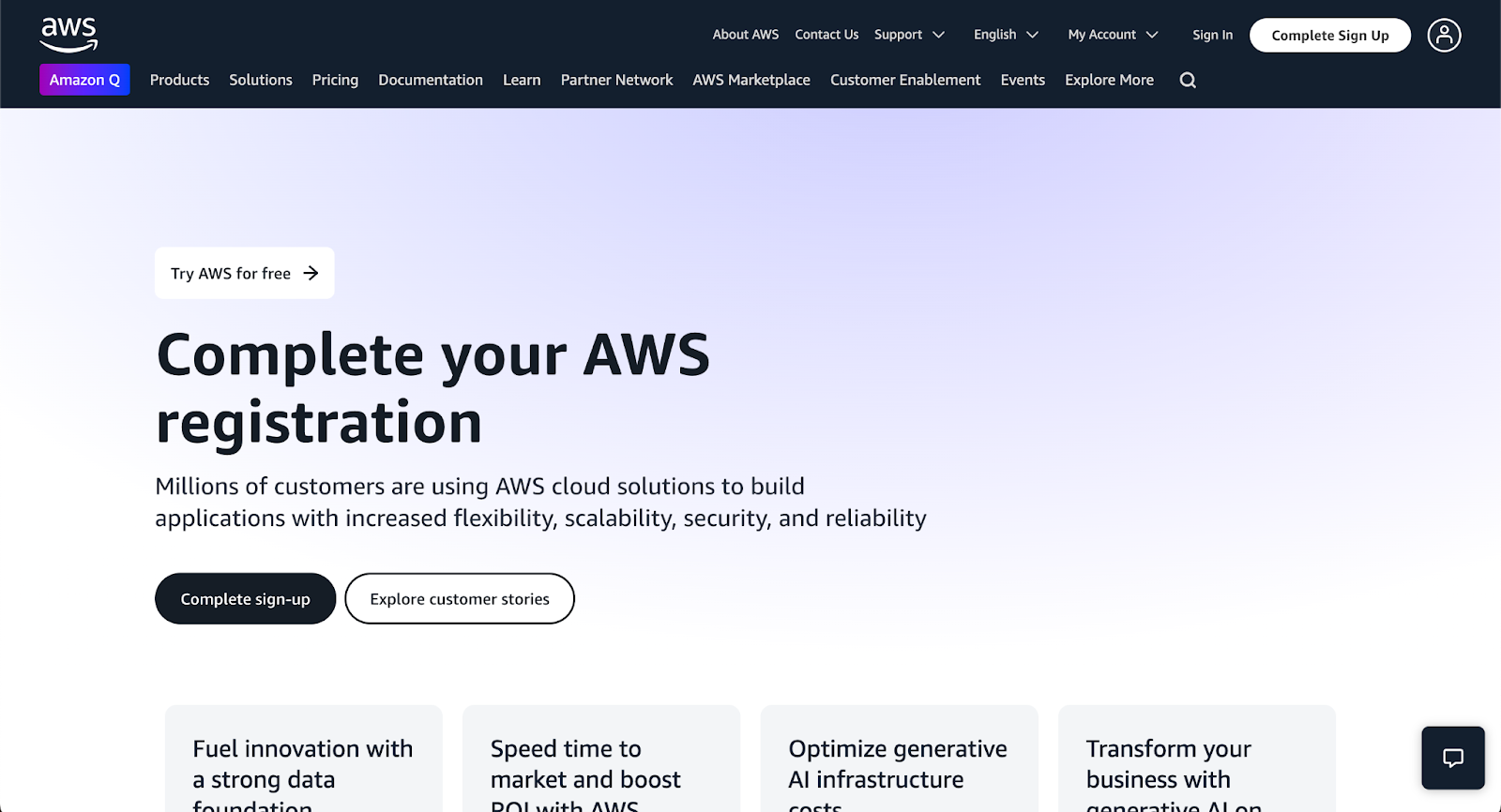
Step 2: Accessing AWS Lightsail console
Once your AWS account is ready, the next step is accessing the AWS Lightsail console. You can do this in two ways:
- To go directly, visit AWS Lightsail console.
- To navigate via the AWS Management console, log in first, then locate Lightsail in the list of services.
Once in the Lightsail console, you’ll see the dashboard, which is divided into key sections: Instances, Networking, Storage, and Snapshots. These tabs contain all the tools needed to manage your Lightsail resources.

AWS Cloud Practitioner
Launching Your First Lightsail Instance
Now that you're in the AWS Lightsail console, you’re ready to launch your first instance.
Step 1: Create an instance
To start, click Create Instance - as shown in the image below. This will take you to the instance creation page.
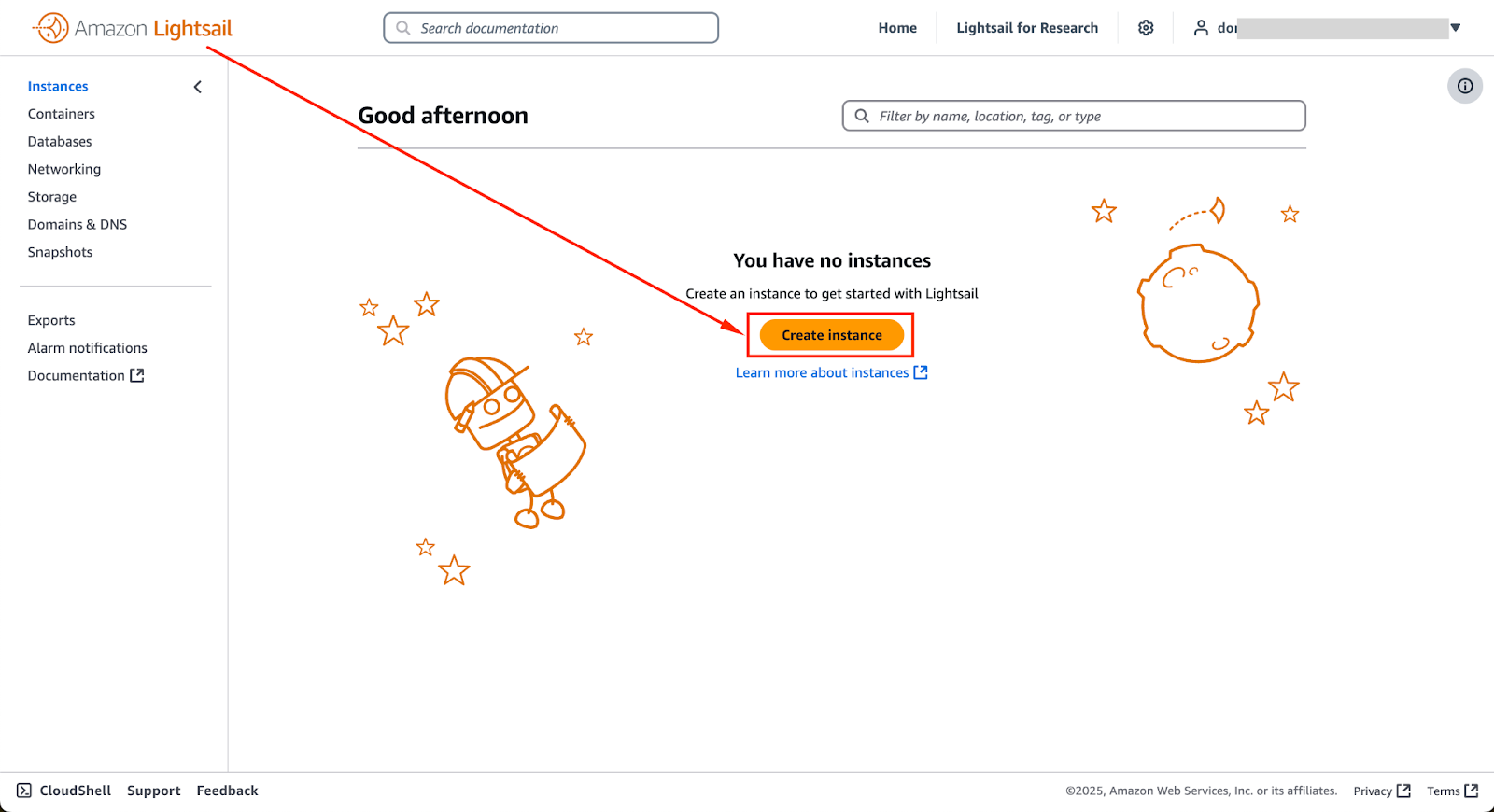
Step 2: Choose an instance image
The image below provides an example of the screen you will see when creating an instance. The exact appearance may vary based on your AWS Region, Availability Zone, and console version.
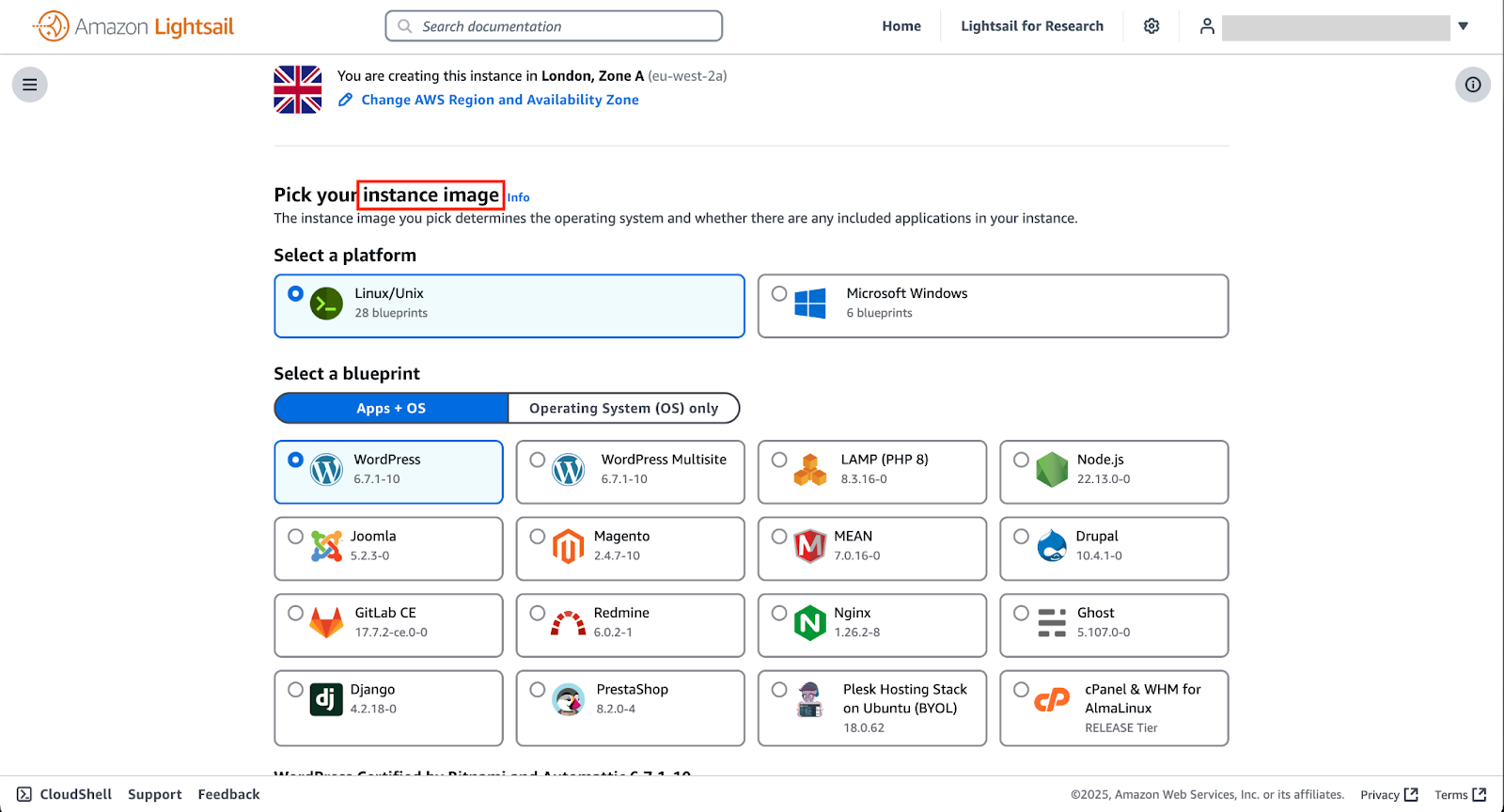
The first choice you have to make is to determine what operating system or pre-configured software stack your instance will use.
Lightsail gives you two options:

- Apps + OS images: If you want to deploy an instance quickly, pick a pre-configured application stack such as WordPress, LAMP, or Node.js. This saves you time by setting up both the OS and the software in one go.
- OS-only images: If you prefer setting up everything from scratch, choose a bare operating system like Ubuntu, CentOS, or Windows. These are great if you need full control over the configuration.
Another decision you have to make is choosing a region for your instance. AWS Lightsail operates from multiple data centers worldwide, and the region you pick will affect the latency and performance of your instance.
If your audience is primarily in North America, an instance in a US-based region will provide faster response times. If you serve users in Europe or Asia, select a region closer to them to minimize delays.
The image below highlights some of the available AWS Regions and Availability Zones. AWS periodically expands its infrastructure by adding new Regions and Availability Zones, so check for updates to find the best option for your needs.
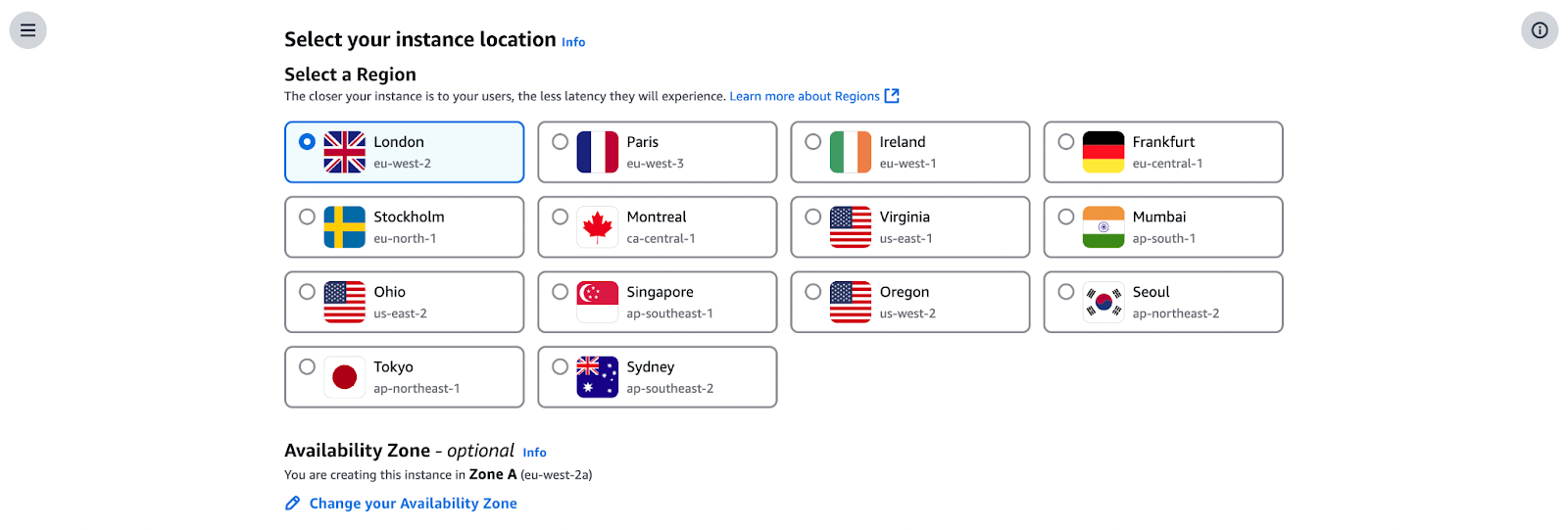
Step 3: Choose an instance plan
Your next step will be to decide on a pricing plan based on your computing needs.
At the time of writing, AWS Lightsail offers fixed-cost plans starting at $5 per month. These prices increase as you add CPU power, RAM, and storage.
The image below displays a selection of available plans, which may be updated periodically.
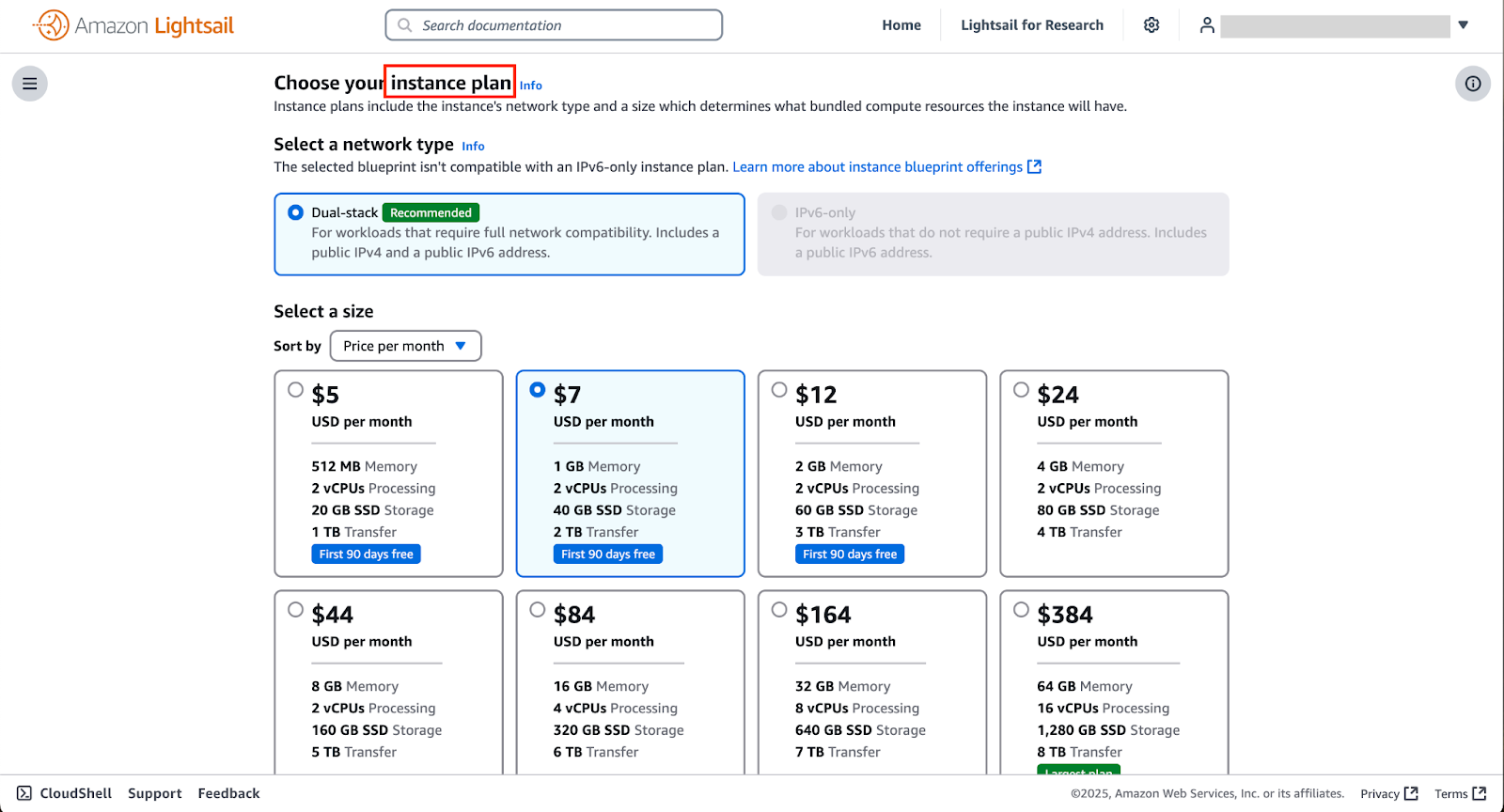
- The basic plan is enough for small websites, test environments, or simple applications.
- If you expect higher traffic or need more processing power, you might want to choose a mid-tier or high-tier plan.
One of Lightsail's benefits is its predictable pricing; there are no unforeseen fees, which makes it an excellent option for those who are new to cloud hosting.
Step 4: Configure instance details
To customize your instance, you should adjust a few settings before launching it:
- Give it a unique name: This makes it easier to identify if you plan to manage multiple instances.
- Set up SSH key pairs: This is a crucial security step. AWS will generate one for you if you don’t already have an SSH key. You will need this later to connect to your instance securely.
- Adjust networking settings: Here, you can configure firewall rules to control which types of traffic are allowed. For example, a web server might need to allow HTTP (port 80) and HTTPS (port 443) while other ports remain restricted for security reasons.
Step 5: Launch your instance
Once everything looks good, click the Create Instance button. It usually takes a few minutes for Lightsail to begin the background setup process.
The image below shows an instance being set up in the background.
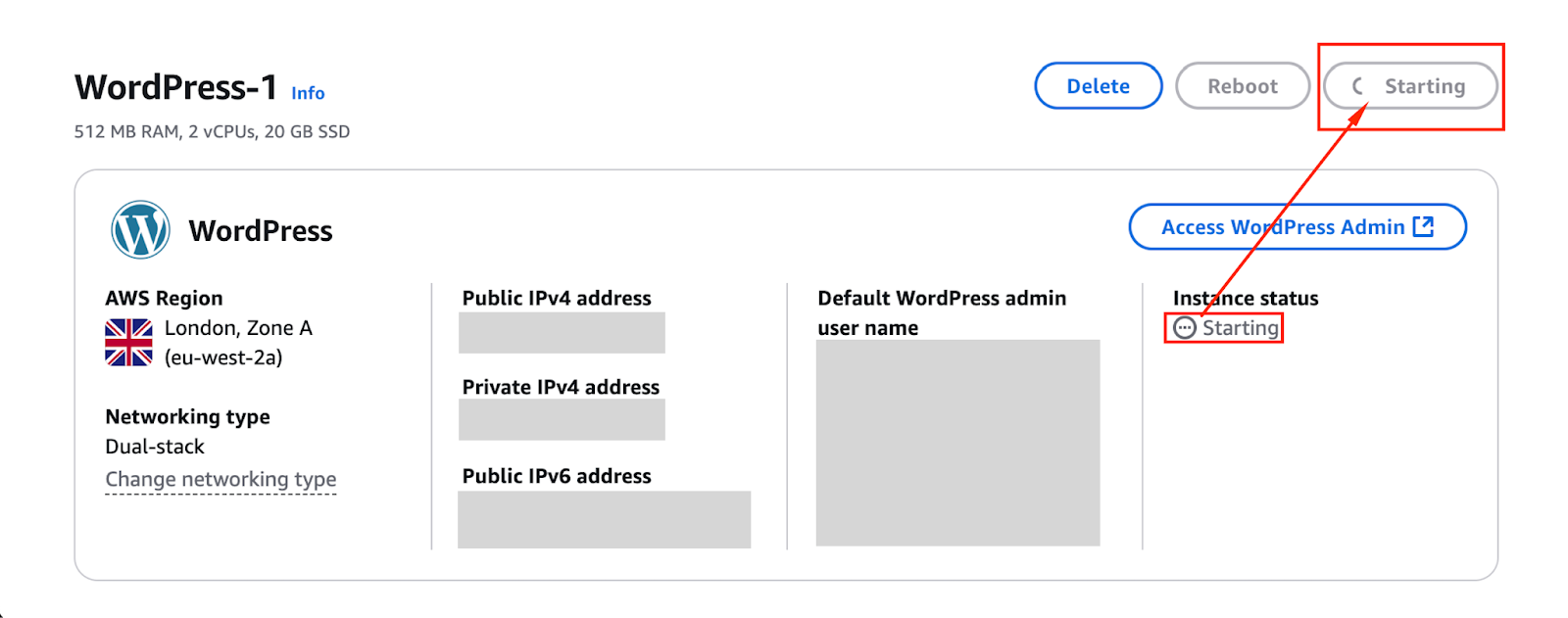
The image below shows a ready instance.
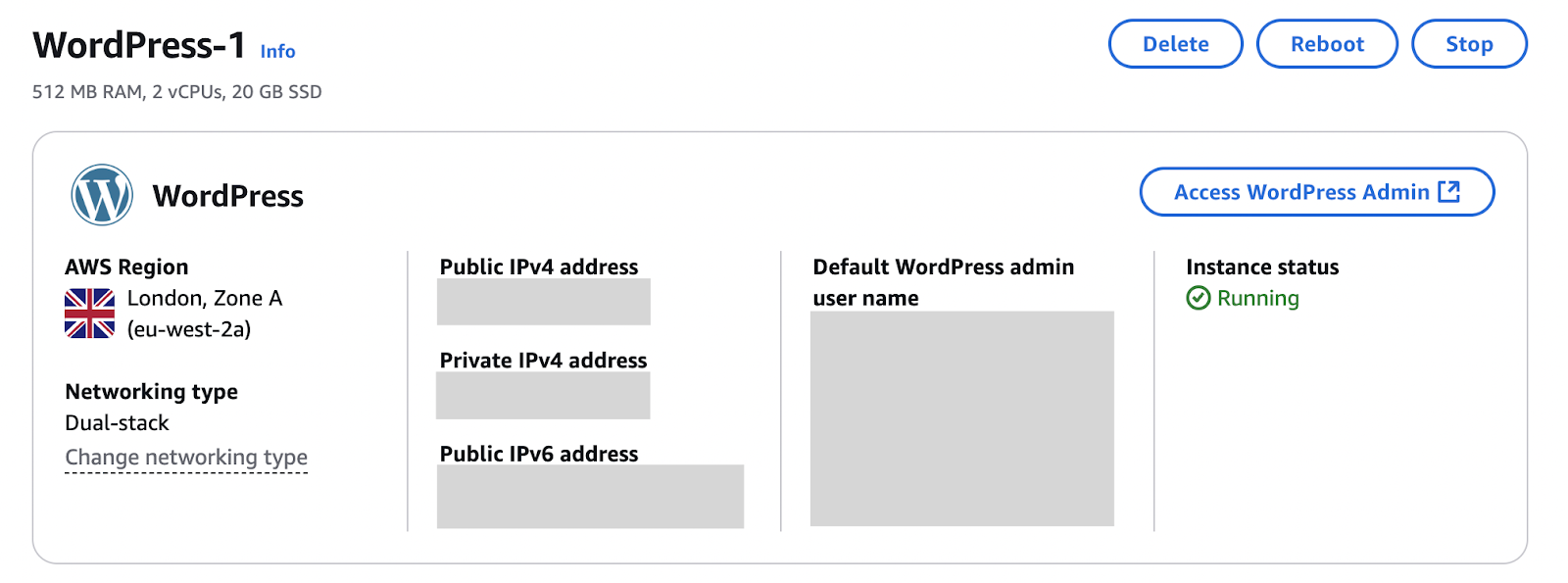
You now have a cloud-based server ready to host your application, website, or development environment!
Managing Your Lightsail Instance
Once your instance is up and running, the next step is managing it effectively. This includes connecting to your instance, taking backup snapshots, and configuring networking for stable and secure access. Let’s go through each of these tasks.
Step 1: Connecting via SSH
You can connect to your instance using SSH directly from the Lightsail console using the built-in terminal.
The images below show where you can connect using SSH and the built-in terminal you will be presented with.
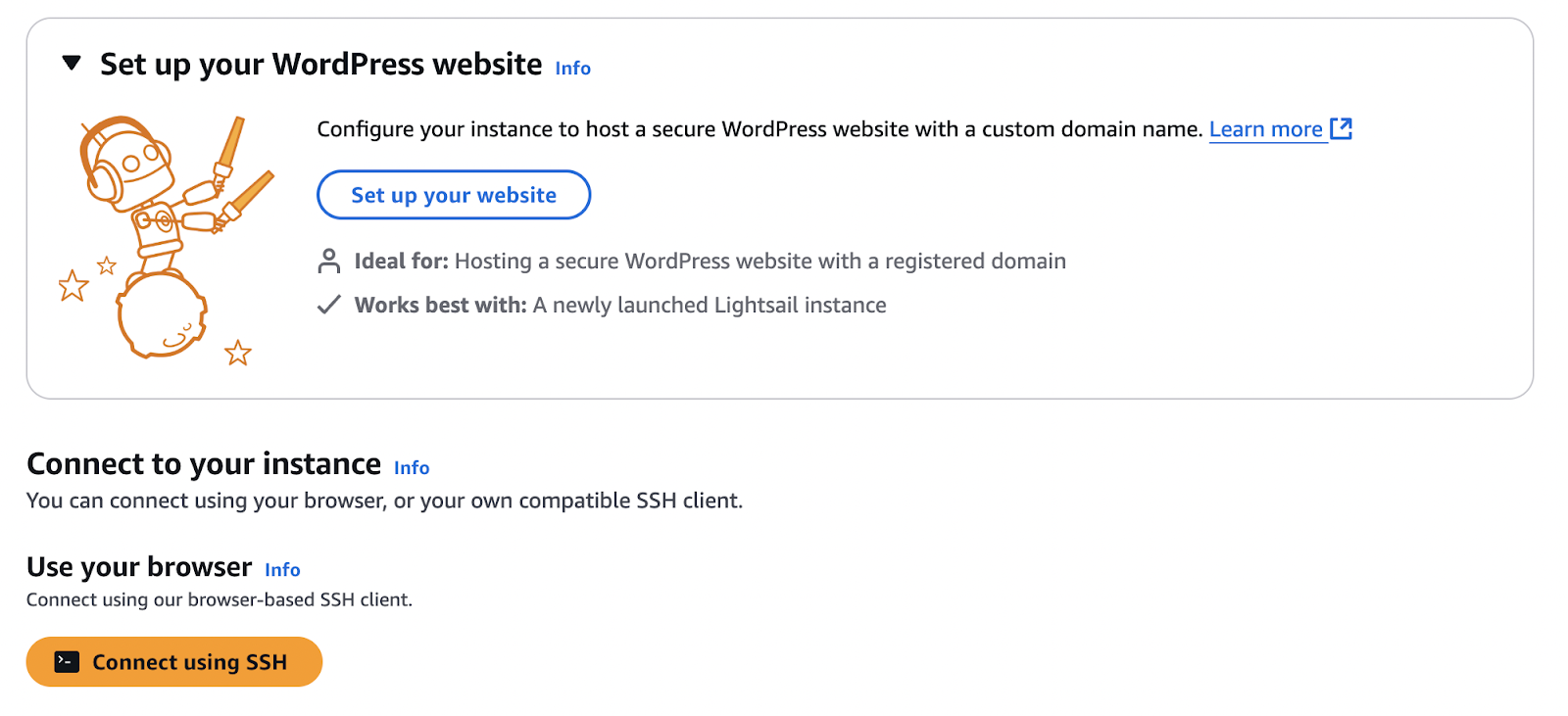

If you prefer using an SSH client like PuTTY, you need the private key from the SSH key pair you set up earlier.
Lastly, check the instance status in the console to make sure your instance is operating as it should.
Step 2: Managing snapshots
Snapshots are essentially backups of your instance and come in handy for disaster recovery or migration.
To create one, go to the Snapshots tab in your instance’s management page and click Create Snapshot.
The image below shows the Snapshots tab in the Lightsail console.
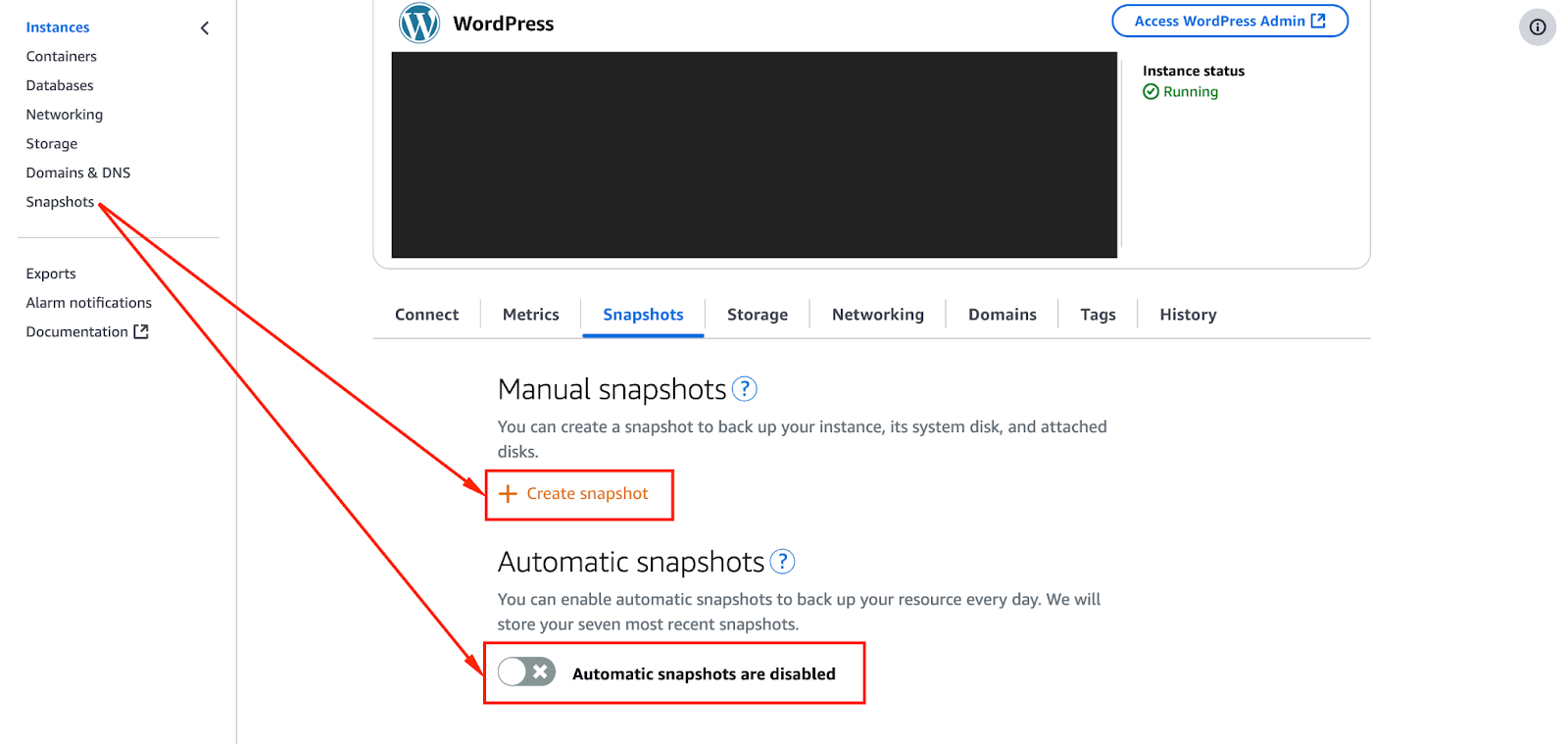
If anything ever goes wrong with your server, you can restore a snapshot to bring it back to a previous state.
Step 3: Managing networking
To ensure stable and reliable access to your instance, you’ll need to configure its networking settings. This includes assigning a Static IP, setting up DNS configurations, and managing firewall rules.
- Assign a Static IP. Without one, your instance's public IP might change if it restarts, which can be a problem if you are running a website or an application that relies on a fixed address.
- Configure DNS settings. Link your domain name to your Lightsail instance. This is useful if you are hosting a website and want visitors to access it using a custom domain rather than an IP address.
- Set up firewall rules. Control who can access your instance by allowing only the necessary traffic—for example, enable SSH (port 22) only for your IP and limit other open ports to trusted sources.
Deploying Applications on Lightsail
With your Lightsail instance set up and networking configured, you’re ready to deploy applications.
Step 1: Installing software
The next step is installing the software you need. To do this, you will need to connect to your instance via SSH.
Remember, if you are using the Lightsail console, you can click the Connect button to open a browser-based terminal. Alternatively, you can use an SSH client like PuTTY or your command line if your SSH key is set up.
You might need software like Apache, MySQL, and PHP for a basic web server setup. You can install them with a single command:
sudo apt update && sudo apt install apache2 -yThe command above updates your package list and installs Apache, which serves web pages to visitors.
Depending on your application, you may also need to install other components, such as PHP for dynamic content or MySQL for database management.
Step 2: Setting up WordPress
If you are deploying a WordPress website, AWS Lightsail makes it even easier. Instead of installing everything manually, you can select the pre-configured WordPress blueprint when creating your instance. This automatically sets up WordPress, MySQL, and all the necessary components.
Once the instance is running, open a web browser and navigate to your Lightsail instance’s public IP address.
You should see the WordPress setup screen, where you’ll configure your site name, admin account, and other settings.
To improve performance, consider enabling caching and setting up a Content Delivery Network (CDN). Lightsail has built-in CDN support, which helps speed up your site by serving content from edge locations closer to your visitors.
Step 3: Deploying a custom web application
If you are working with a custom web application instead of WordPress, you will need to upload your code manually.
The easiest ways to transfer files to your instance are:
- SCP (Secure Copy Protocol) – If you just need to upload a few files, you can use SCP to securely transfer them from your local machine.
- Git – If your code is stored in a Git repository, you can clone it directly onto your Lightsail instance using:
git clone https:// github. com/name-of-your-repoAfter uploading your files, you will need to install dependencies.
For example, if you are running a Node.js application, you might install dependencies with:
npm installNext, configure your web server. If you are using Nginx, you must set up a configuration file to serve your application properly.
Finally, store sensitive information securely using environment variables instead of hardcoding them in your application. You can do this by exporting variables in your shell or using a .env file that your application reads.
Once everything is set up, restart your web server and check that your application is running correctly.
At this point, your custom app is live on AWS Lightsail!
If you are specifically interested in learning how to deploy and manage AWS EC2 instances, have a look at AWS EC2 Tutorial for Beginners, which covers key concepts and configurations.
Scaling and Optimizing Lightsail
As your application grows, you may need to improve performance, handle more traffic, or increase storage capacity. AWS Lightsail provides several ways to scale and optimize your setup, whether by upgrading your instance, distributing the load, or expanding storage.
Step 1: Scaling your instance
You have two primary choices if your Lightsail instance is having trouble keeping up:
- Upgrade to a bigger plan (scale vertically) – This means creating a new, more powerful instance and moving your data over. AWS does not offer an automatic upgrade, so you will need to handle migration manually.
- Scale horizontally – Instead of just one bigger instance, you can also choose to spread the load across multiple smaller ones. You can pair this with a Lightsail load balancer to keep things running smoothly.
Step 2: Adding more storage
If you are running out of space, you can do the following:
1. Navigate to the Storage section and attach a new block storage volume.
2. Use the following command to mount it to your instance:
sudo mount /dev/xvdf /mnt/new_storage3. If you want this to persist after a reboot, update /etc/fstab.
Step 3: Load balancing
If traffic spikes, you can use a load balancer. A load balancer distributes incoming requests across multiple instances, keeping performance steady.
Lightsail’s built-in load balancer makes this easy.
You can also automate instance deployment with snapshots and scripts for better scaling.
If you want a structured path to becoming an AWS-certified professional, consider the AWS Cloud Practitioner (CLF-C02) certification track. It will help you better understand AWS services and best practices.
Monitoring and Security in Lightsail
Keeping your Lightsail instance running smoothly and securely requires proactive monitoring and proper security measures. By tracking performance metrics and following security best practices, you can prevent issues before they impact your application.
Monitoring performance
The Metrics tab allows you to monitor your instance’s health. You can check CPU usage, network traffic, and storage.
If something looks wrong, set up alerts to catch issues before they become serious problems.
Securing your instance
You can secure your Lightsail instance with these simple steps:
- Disable root login – Use key-based SSH authentication instead for better security.
- Tighten firewall rules – Only open the ports you actually need.
- Enable automatic updates – This helps patch vulnerabilities without extra effort.
Conclusion
I’ve found AWS Lightsail to be a great option for developers and small businesses who need a simple, scalable, and cost-effective cloud hosting solution. It takes the complexity out of AWS while still giving you the flexibility to deploy and manage applications with ease.
If you’re looking to deepen your AWS skills, I highly recommend checking out these courses:
- AWS Security and Cost Management – Learn how to secure your AWS environment and keep costs under control.
- Introduction to AWS Boto in Python – Get hands-on with automating AWS services using Python and boto3.
AWS Cloud Practitioner
FAQs
Is AWS Lightsail suitable for hosting a production website?
Yes, AWS Lightsail can be used for production websites - especially for small to medium-scale applications. However, consider upgrading to AWS EC2 for high-traffic websites.
How does AWS Lightsail handle backups and disaster recovery?
AWS Lightsail provides snapshot functionality to create backups of your instance. You can restore snapshots to recover data in case of failures.
Can I use AWS Lightsail for WordPress hosting?
Yes, AWS Lightsail offers a pre-configured WordPress blueprint that simplifies the installation and setup process, making it an excellent choice for hosting WordPress sites.
How do I scale my AWS Lightsail instance if my website traffic increases?
You can upgrade your instance to a higher plan or use a load balancer to distribute traffic among multiple instances for better scalability.
What security measures should I take when using AWS Lightsail?
Implement security best practices such as using SSH key authentication, disabling root login, enabling a firewall, keeping software updated, and securing web applications with SSL certificates.
How do I migrate from AWS Lightsail to EC2?
The Export to EC2 feature in the Lightsail console allows you to take a snapshot of your Lightsail instance and export it to Amazon EC2, allowing you to transition to more advanced AWS services.
How do I connect a custom domain to my Lightsail instance?
You can configure DNS settings in Lightsail’s networking tab or use Route 53 for advanced domain management.
